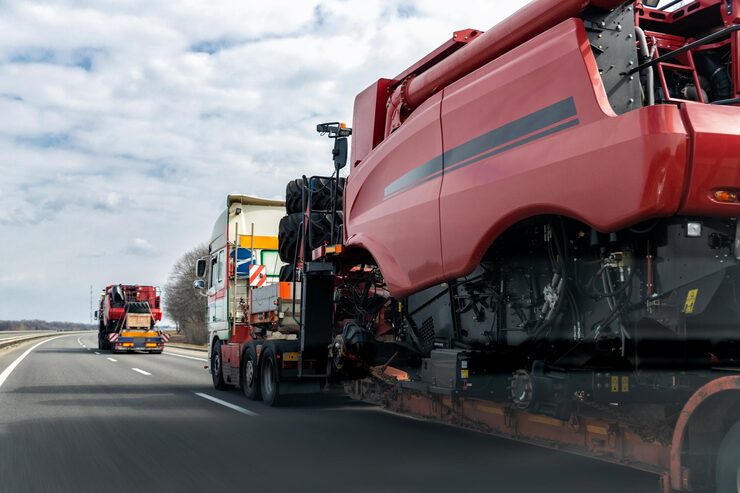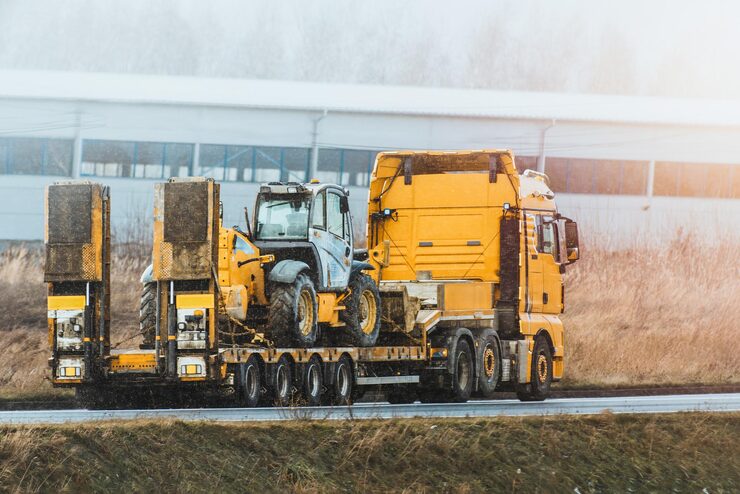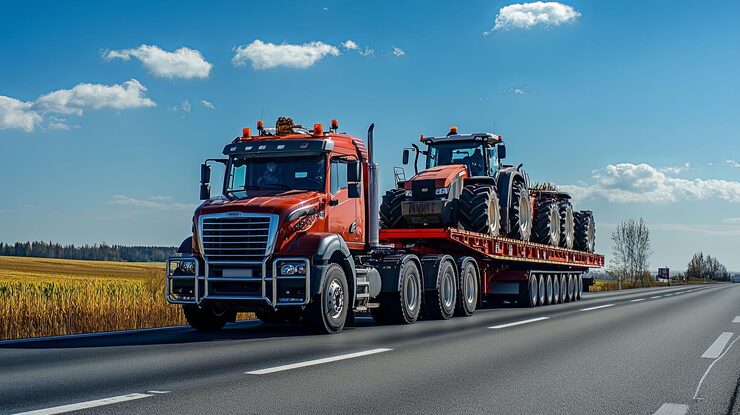Table of Contents
Key Takeaways
✔ Heavy haul tracking safely moves oversized and overweight loads.
✔ It covers loads exceeding legal size or weight limits requiring permits.
✔ It relies on specialized trailers, permits, transport, and safety.
✔ The process includes assessment, permits, planning, and delivery.
✔ Many industries use it to move essential heavy equipment.
✔ A warehouse in New York supports storage and coordination.
✔ Challenges include regulations, weather, and coordination.
Moving massive equipment or oversized cargo isn’t as simple as loading it onto a standard truck. That’s where heavy haul trucking comes in—a specialized service designed to transport loads that exceed normal size or weight limits safely and efficiently. From construction machinery to wind turbine components, this type of trucking plays a crucial role in keeping large-scale industries running smoothly.
Here are the key things to know about heavy haul trucking and how it all works.
What Is Heavy Haul Trucking?
Heavy haul trucking is a specialized service for moving loads that are too large or heavy for standard trucks. These loads exceed normal road limits—typically more than 8.6 feet wide, 13.6 feet high, 53 feet long, or weighing over 80,000 pounds.
Its main purpose is to transport oversized cargo safely and legally. Industries like construction, energy, and manufacturing rely on this service to move equipment such as bulldozers, turbines, and large machinery efficiently and securely.
What Is Considered Heavy Haul Trucking
Heavy haul trucking covers loads that exceed standard size or weight limits on public roads. Since regulations vary by state, it’s important to understand what qualifies as a heavy haul load to plan properly and stay compliant.
- Exceeds legal limits for height, width, length, or weight
- Common examples include construction cranes, industrial boilers, and wind turbine components
- Requires special state and federal permits for transport
- Needs detailed route planning and possible escort vehicles
- Must follow safety regulations and travel restrictions to avoid fines or delays

Key Components of Heavy Haul Trucking
Specialized Equipment
Moving oversized loads requires more than a regular truck. Heavy haul trucking uses specialized trailers like lowboy or RGN (Removable Gooseneck) trailers built to handle extreme weight and size. These sit close to the ground for better stability and clearance, often using multiple axles to distribute weight evenly. The right truck and trailer combination ensures heavy cargo moves safely through steep grades and tight turns.
Permits and Compliance
Every heavy haul trucking job must follow strict state and federal rules. Special permits confirm that the truck’s size and weight are approved for the route and specify safety needs like signage and escort vehicles. Skipping permits can lead to delays or fines, so many companies work with experts to manage compliance from start to finish.
Route Planning and Surveys
Planning routes for oversized loads involves more than GPS navigation. Carriers often perform physical surveys to spot low bridges, sharp turns, or power lines. Careful planning keeps the trip safe and reduces disruptions. Some routes also require coordination with utility or local authorities for temporary road adjustments.
Escorts and Safety Protocols
Safety is critical in heavy haul trucking, especially with rising accident rates. In 2023, 5,375 large trucks were involved in fatal crashes—an 8.4% drop from 2022 but a 43% rise over the past decade. To prevent incidents, oversized loads use escort vehicles, secure tie-downs, and clear signage, usually traveling during daylight for maximum visibility and safety.
The Heavy Haul Trucking Process (Step-by-Step)
Heavy haul trucking involves multiple steps, each carefully planned to ensure a successful move:
- Load Assessment: The cargo is measured and weighed to determine if it qualifies as a heavy haul.
- Equipment Selection: The right trailer and truck combination is chosen for stability and support.
- Permit Application: Carriers apply for state and federal permits before departure.
- Route Survey: A physical inspection helps identify possible hazards along the route.
- Execution: The truck, driver, and escort vehicles work together to complete the transport.
- Delivery and Offloading: At the destination, specialized equipment is used to safely unload the cargo.

Industries That Depend on Heavy Haul Trucking
Heavy haul trucking plays a vital role across multiple industries that rely on moving oversized and overweight cargo. These industries depend on it to deliver heavy equipment, machinery, and materials safely and efficiently.
- Construction and Infrastructure
- Energy Sector
- Manufacturing and Warehousing
- Marine Industry
- Aerospace Industry
How a Warehouse in New York Supports Heavy Haul Trucking
For many companies, using a warehouse in New York makes heavy haul logistics more efficient. New York’s location offers direct access to ports, railways, and major highways like I-87 and I-95—ideal for both inbound and outbound oversized shipments.
A strategically placed warehouse in New York also provides valuable staging space for preparing or storing large loads before transport. These facilities often handle crating, packaging, and inventory management, helping ensure that every piece of cargo is ready when the trucks arrive.
Additionally, having a trusted warehouse partner simplifies coordination. Shipments can be inspected, documented, and loaded in a controlled environment, reducing the risk of delays or damage. This combination of warehousing and heavy haul trucking makes large-scale logistics smoother and more reliable for businesses across the Northeast.
Challenges and Considerations in Heavy Haul Trucking
Heavy haul trucking involves more than just transporting oversized loads—it requires detailed coordination, safety planning, and regulatory awareness. Every trip presents unique challenges that must be carefully managed to ensure success.
- Regulatory Differences: Each state has its own size, weight, and permit rules, which makes planning multi-state routes complex. Plus, staying compliant with these varying regulations often requires extra investments in technology and driver training—adding to the overall operational costs for trucking companies.
- Weather Conditions: Rain, snow, and high winds can delay schedules or make certain roads unsafe for large loads.
- Insurance Requirements: Oversized cargo often carries a high value, requiring specialized insurance coverage to protect against potential damage or delays.
- Coordination Needs: Trucking companies, escort drivers, utility providers, and warehouse teams must work together to handle every stage of transport smoothly.
- Safety Concerns: Proper load securing, route planning, and communication between drivers and escorts are essential to prevent accidents and ensure road safety.
Frequently Asked Questions
What types of loads usually require heavy haul trucking?
Heavy haul trucking is used for moving large or overweight items that can’t fit on standard trailers. This includes construction equipment, wind turbines, industrial machinery, and even large bridge beams. Any load that exceeds size or weight limits set by federal or state laws typically needs a heavy haul carrier.
How far can heavy haul trucks travel?
Heavy haul trucks can travel long distances, even across multiple states, depending on the permits and routes approved. However, travel times are often restricted to daylight hours or specific days for safety reasons. Planning and scheduling are critical to ensure compliance with each state’s regulations.
How long does it take to plan a heavy haul shipment?
Planning a heavy haul shipment can take anywhere from a few days to several weeks. The timeline depends on the size of the load, the distance, and how many permits are required. Route surveys, inspections, and coordination with authorities can also extend preparation time.
What safety measures are taken during transport?
Safety is a top priority in heavy haul trucking. Drivers use secure tie-downs, safety flags, warning lights, and “Oversized Load” signage. Escort vehicles are also used to warn other drivers and help guide the truck through tight or busy areas.
What happens if a route obstacle is found during transport?
If an obstacle like a low bridge or construction zone is encountered, the route may need to be adjusted immediately. Dispatch teams work closely with local authorities and the driver to find an alternate path. This is why route planning and real-time communication are so important in heavy haul operations.

Power New York, NY logistics with 3PL Warehouse By Best!
3PL Warehouse By Best delivers dependable, high-performance warehousing solutions designed for fast-moving industries in New York, NY. With advanced storage systems, precision handling, and expert logistics management, every shipment moves efficiently from dock to destination. A trusted 3PL warehouse in New York, NY keeps operations organized, timelines sharp, and inventory under control. Businesses across New York, NY depend on our experience to handle even the most complex logistics demands with confidence.
Connect with 3PL Warehouse By Best today to start building a smarter logistics strategy in New York.

